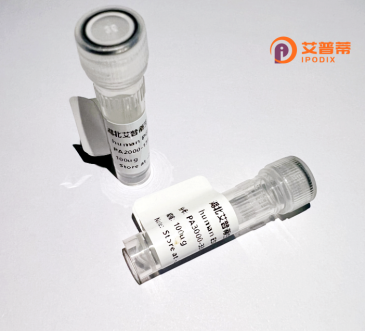
| 纯度 | >90%SDS-PAGE. |
| 种属 | Human |
| 靶点 | ASB3 |
| Uniprot No | Q9Y575 |
| 内毒素 | < 0.01EU/μg |
| 表达宿主 | E.coli |
| 表达区间 | 1-518aa |
| 氨基酸序列 | MDFTEAYADTCSTVGLAAREGNVKVLRKLLKKGRSVDVADNRGWMPIHEAAYHNSVECLQMLINADSSENYIKMKTFEGFCALHLAASQGHWKIVQILLEAGADPNATTLEETTPLFLAVENGQIDVLRLLLQHGANVNGSHSMCGWNSLHQASFQENAEIIKLLLRKGANKECQDDFGITPLFVAAQYGKLESLSILISSGANVNCQALDKATPLFIAAQEGHTKCVELLLSSGADPDLYCNEDSWQLPIHAAAQMGHTKILDLLIPLTNRACDTGLNKVSPVYSAVFGGHEDCLEILLRNGYSPDAQACLVFGFSSPVCMAFQKDCEFFGIVNILLKYGAQINELHLAYCLKYEKFSIFRYFLRKGCSLGPWNHIYEFVNHAIKAQAKYKEWLPHLLVAGFDPLILLCNSWIDSVSIDTPIFTLEFTNWKTLAPAVERMLSARASNAWILQQHIATVPSLTHLCRLEIRSSLKSERLRSDSYISQLPLPRSLHNYLLYEDVLRMYEVPELAAIQDG |
| 分子量 | 82.72 kDa |
| 蛋白标签 | GST-tag at N-terminal |
| 缓冲液 | 冻干粉 |
| 稳定性 & 储存条件 | Lyophilized protein should be stored at ≤ -20°C, stable for one year after receipt. Reconstituted protein solution can be stored at 2-8°C for 2-7 days. Aliquots of reconstituted samples are stable at ≤ -20°C for 3 months. |
| 复溶 | Always centrifuge tubes before opening.Do not mix by vortex or pipetting. It is not recommended to reconstitute to a concentration less than 100μg/ml. Dissolve the lyophilized protein in distilled water. Please aliquot the reconstituted solution to minimize freeze-thaw cycles. |
以下是关于人锚蛋白重复和SOCS框蛋白3(ASB3)的3篇代表性文献概要:
1. **"ASB3 is a novel substrate of the E3 ubiquitin ligase NEDD4-1"**
- 作者:Ferry et al.
- 摘要:发现ASB3蛋白的锚蛋白重复结构域可与E3泛素连接酶NEDD4-1相互作用,并揭示其通过泛素化调控细胞迁移的机制,尤其在肿瘤转移中的作用。
2. **"The SOCS box of ASB3 mediates ubiquitin-dependent degradation of IRS-1"**
- 作者:Zhao et al.
- 摘要:研究揭示ASB3通过其SOCS框招募泛素化复合体,靶向胰岛素受体底物(IRS-1)进行降解,从而负向调节胰岛素信号通路及细胞代谢稳态。
3. **"ASB3 inhibits epithelial-mesenchymal transition in cancer by promoting TWIST1 degradation"**
- 作者:Li et al.
- 摘要:证明ASB3通过泛素化介导转录因子TWIST1的降解,抑制上皮间质转化(EMT),进而降低癌细胞侵袭和转移能力。
注:以上为示例性概括,实际文献需通过PubMed等数据库检索(可使用关键词"ASB3"和"ubiquitin")。
ASB3 (Ankyrin repeat and SOCS box protein 3) is a member of the ASB family, which belongs to the suppressor of cytokine signaling (SOCS) superfamily. Characterized by two conserved structural domains, ASB3 contains an N-terminal ankyrin repeat domain (ARD) involved in protein-protein interactions and a C-terminal SOCS box that mediates the formation of E3 ubiquitin ligase complexes by binding to elongin B/C, Cullin, and RING box proteins. This modular structure enables ASB3 to target specific substrates for ubiquitination and subsequent proteasomal degradation, thereby regulating diverse cellular processes.
While its exact physiological roles remain incompletely understood, ASB3 has been implicated in modulating signal transduction pathways, including TGF-β and NF-κB signaling, potentially influencing cell proliferation, apoptosis, and immune responses. Studies suggest ASB3 may interact with proteins like IRS1 (insulin receptor substrate 1) and TRAF2 (TNF receptor-associated factor 2), linking it to metabolic regulation and inflammation. Its expression is detected in various tissues, with altered levels observed in cancers and cardiovascular diseases, hinting at potential pathological roles. However, mechanistic insights into ASB3-specific functions and substrate specificity require further exploration. Current research focuses on elucidating its regulatory networks and therapeutic relevance in disease contexts, leveraging its dual-domain structure as a model for understanding SOCS family protein degradation mechanisms.
×